I did a search on the forum but did not come across references to effects of the eye on the autonomic nervous system as presented by Dr. Kaisu Viikari (she's an ophthalmologist). She also appears to have done pretty impressive work with regards to the development and prevention of myopia.
I apologise for the lenghty post, but I will try to summarize the essentials, as perhaps the information will be beneficial to interested people. (For the big picture, Dr. Viikari’s website is very well made and informative: _www.kaisuviikari.com)
So, it appears majority of humans are born hyperopic (hypermetropic), meaning that the eye is ”too short” as shown in the image:

For such an eye to see clearly in the distance, the accommodation muscle around the lens of the eye (ciliary muscle) has to contract to cause the lens to thicken, increase the refraction and lead to the images in the distance to focus on the retina:

It would appear that as such the eye is defective. However, the eye being too short enables seeing in the dark permitting hunting, etc., which was essential during paleolithic times. (If the person had an absolute normal refraction (emmetropia), he could not cope with the myopia provoked by darkness (so called ”night myopia”). The lens of the eye is incapable of reducing its refractive power from its original thickness.)
To see up close the hyperopic eye needs to accommodate even more (as seen in the below picture), and herein lies the problem.

In the olden times close work was minimal. In the modern world on the other hand reading, computers, etc. require an immense amount of close work demanding a lot of labor from the ciliary muscle. As any other muscle, the ciliary muscle can become spasmic and end up in a ”cramp”. In this situation the lens can remain in a thickened position, and the distance vision can be blurry. The situation is known as pseudomyopia, or school myopia:

If minus glasses are prescribed for a pseudomyopic eye with advice to read with them as well (as unfortunately is done routinely by the ophthalmologic profession), it locks the situation, and the accommodation spasm of the eye can’t release. With the person doing close work with these glasses, the situation actually deteriorates, the spasm worsens and the distance vision weakens. Often stronger minus glasses are prescribed.
Eventually the eyeball itself will lenghten, as the workings of the ciliary muscle cause the eye to grow axially (in a younger eye) causing anatomical myopia:

At the pseudomyopic phase, the situation could be reversed. This would require the use of glasses with plus additions when doing close work. In this way less accommodation is required from the ciliary muscle and it gets a chance to relax, with the distance vision improving:

If an axial, anatomical myopia has developed it is irreversible. However as there is an accommodation spasm present (that has driven the eye to lenghten), this portion of the total myopia can be reversed. The vision can improve to some degree (e.g. from -5 to -3.5) and worsening of the myopia is prevented. Also the possibility of many myopia related complications, like retinal detachment, is diminished.
For myopia and pseudomyopia prevention, Viikari suggests getting plus glasses (+3.0) for close work as early as possible.
All of the above shines a whole new light on refractive surgery, for example.
Everyone is individual, and some people of course do not produce (pseudo)myopia. I have understood that they might possibly be so hyperopic to start with, that the accommodation spasm worsening and the possible lenghtening of the eyeball do not cause things to go ”to the minus side”: the person’s distance vision doesn’t deteriorate. Thus they remain ”undiagnosed hyperopes” (latent hyperopia). The problem here is that as the accomodation process is linked with the autonomic nervous system, spasm of the ciliary muscle can potentially cause a plethora of problems from migraines to headaches, and more (of course this applies to the pseudomyopic situation as well). Writes Dr. Viikari:
and:

To alleviate these problems and release the spasm sufficiently a (latent) hyperope should have appropriate plus glasses for near, and far (as hypeopic eye has to accomodate to focus distant objects to the retina, as mentioned above).
A myopic person should try having weaker minus glasses for distance, and even weaker ones for close work. With both the myope and hyperope if/ when the accommodation spasm relieves and and the vision improves, new pairs of glasses will be necessary.
Viikari advices that especially older (over 35 yrs) people’s ”far” glasses should be bifocals (with age the lens of the eye becomes less flexible, with the accommodation muscle having to do more work, and near work becomes more difficult and tougher. Personal note: perhaps with the improved diet the flexibility of the lens could be maintained longer?). If looking from far to close, through ”full” monofocal minus glasses for example, one stresses the spasmic accommodation muscle with every glance. With the bifocal, the lower part has plus additions. An example:

Progressive multifocal lenses are pushed to people, as they have no discernible ”lines”, but according to Viikari:
There are variations to the bifocals:
Dr. Viikari is now retired, but in her time she really seemed to have to fight the establishment and received the usual harrassment reserved for someone trying introduce new paradigm-changing and people helping concepts (she successfully treated thousands of migraine patients). Corruption of science, indeed. A good review of Viikari’s experiences: _http://www.doyletics.com/arj/struggle.htm.
In my understanding, to this day these concepts are unfortunately not widely, if at all, acknowledged by ophthalmologists and opticians.
I apologise for the lenghty post, but I will try to summarize the essentials, as perhaps the information will be beneficial to interested people. (For the big picture, Dr. Viikari’s website is very well made and informative: _www.kaisuviikari.com)
So, it appears majority of humans are born hyperopic (hypermetropic), meaning that the eye is ”too short” as shown in the image:

a) A hypermetropic eye: parallel rays of light come to focus behind the retina
For such an eye to see clearly in the distance, the accommodation muscle around the lens of the eye (ciliary muscle) has to contract to cause the lens to thicken, increase the refraction and lead to the images in the distance to focus on the retina:

b) A hypermetropic eye: parallel rays of light are brought to a focus upon the retina by increasing the refractivity by accommodation.
It would appear that as such the eye is defective. However, the eye being too short enables seeing in the dark permitting hunting, etc., which was essential during paleolithic times. (If the person had an absolute normal refraction (emmetropia), he could not cope with the myopia provoked by darkness (so called ”night myopia”). The lens of the eye is incapable of reducing its refractive power from its original thickness.)
To see up close the hyperopic eye needs to accommodate even more (as seen in the below picture), and herein lies the problem.

Rays of light coming from near demand the lens to become even thicker.
In the olden times close work was minimal. In the modern world on the other hand reading, computers, etc. require an immense amount of close work demanding a lot of labor from the ciliary muscle. As any other muscle, the ciliary muscle can become spasmic and end up in a ”cramp”. In this situation the lens can remain in a thickened position, and the distance vision can be blurry. The situation is known as pseudomyopia, or school myopia:

b) A pseudomyopic eye. The situation in a spasm of accommodation: the lens of an emmetropic or hypermetropic eye fixed in its swollen state, in a spasm of accommodation (provoked by close work); the eye still has additional power of accommodation. Light rays coming from infinity (broken line) are refracted to a point in front of the retina. Correction with minus lenses leads to a vicious circle of myopia.
If minus glasses are prescribed for a pseudomyopic eye with advice to read with them as well (as unfortunately is done routinely by the ophthalmologic profession), it locks the situation, and the accommodation spasm of the eye can’t release. With the person doing close work with these glasses, the situation actually deteriorates, the spasm worsens and the distance vision weakens. Often stronger minus glasses are prescribed.
Eventually the eyeball itself will lenghten, as the workings of the ciliary muscle cause the eye to grow axially (in a younger eye) causing anatomical myopia:

a) A real, axial myopia (elongation of the axis of the eye).
An excellent illustration of this mechanism is given by Norman L Adel in his work (Electromyographic and entoptic studies suggesting a theory of the ciliary muscle in accommodation for near and its influence on the development of myopia. Am J Optom 1966;43:27.). In this work, he describes how the "stellated" muscle fibres, which resemble narrowing and widening diamond shapes, stretch the surface layers of the eyeball. The still elastic eyeball of a young person is essential in this development. This leads to the axial lengthening of the eyeball, or myopia.
At the pseudomyopic phase, the situation could be reversed. This would require the use of glasses with plus additions when doing close work. In this way less accommodation is required from the ciliary muscle and it gets a chance to relax, with the distance vision improving:

c) In order to control the situation and release the spasm of accommodation the need for accommodation is suppressed by placing a plus lens in front of the eye. To begin with the reading distance will drop, but will lengthen again as the spasm is released. At the same time, distant vision without glasses begins to improve.
If an axial, anatomical myopia has developed it is irreversible. However as there is an accommodation spasm present (that has driven the eye to lenghten), this portion of the total myopia can be reversed. The vision can improve to some degree (e.g. from -5 to -3.5) and worsening of the myopia is prevented. Also the possibility of many myopia related complications, like retinal detachment, is diminished.
For myopia and pseudomyopia prevention, Viikari suggests getting plus glasses (+3.0) for close work as early as possible.
All of the above shines a whole new light on refractive surgery, for example.
Everyone is individual, and some people of course do not produce (pseudo)myopia. I have understood that they might possibly be so hyperopic to start with, that the accommodation spasm worsening and the possible lenghtening of the eyeball do not cause things to go ”to the minus side”: the person’s distance vision doesn’t deteriorate. Thus they remain ”undiagnosed hyperopes” (latent hyperopia). The problem here is that as the accomodation process is linked with the autonomic nervous system, spasm of the ciliary muscle can potentially cause a plethora of problems from migraines to headaches, and more (of course this applies to the pseudomyopic situation as well). Writes Dr. Viikari:
Migraine is one of the main themes of my books. Migraine is a chaos in the autonomic nervous system. As positive accommodation irritates the parasympathetic and negative accommodation the sympathetic nervous system, the disruption in the balance of these functions results in a chaos which extremely frequently is the fundamental cause of migraine.
In an article, Friedman mentions that ophthalmologists have found correction of refractive error to result in considerable improvement in 90% of migraine patients treated.(Friedman AP: Treatment of migraine. N Engl J Med 1954:250;600-2)
and:
The inseparable connection between accommodation and the autonomic nervous system, which is behind all display symptoms, became clear to me at a very early stage, of which I will never cease to be grateful. Very likely, this was the impetus that determined the orientation of my whole life's work. As I was working on my thesis, I had to drop substances irritating the parasympathetic nervous system (including pilocarpine) in the eye of a rabbit, after which the rabbit almost instantaneously had diarrhoea; in other words, a parasympathetic peristaltic reaction of the bowel caused by a small amount of a substance.
Using atropine to inhibit a spasm in m. ciliaris and reveal latent hyperopia is one of the first things that students of the field come across, especially with children. Already at this stage students using their brains should understand what an important factor accommodation is in the general reactions of the body. These examination drops often cause many types of generalised symptoms, arrhythmia, rise of temperature, and restlessness amounting to disorientation, so that the parents downright begin to panic. It is my understanding that these symptoms are in proportion to the degree of hyperopia revealed.
It is also interesting that as the increase of pluses stimulates the sympathetic nervous system, its effects are comparable to e.g. the use of amphetamine. This is why it is possible that the patient can even become addicted to plus increases and provoke the ophthalmologist to unnecessarily great increases in the pluses. This kind of a situation naturally is very rare, but it is good to be aware of this possibility, too.
An important ganglion, ganglion ciliare, is located behind the eyeball. Despite its small size of a few millimeters, it is one of the most central ganglions in our bodies, from which extend wide-reaching connections like branches of a tree. The attached illustrates the way neural pathways from here travel like reins both to the brain and spinal nerves and the autonomic nervous system

When the whole nervous system is entwined in it, mastering this issue requires not only an in-depth understanding of not only the accommodation event but also anatomy and physiology as well as a multidisciplinary, integrating interest.
In other words, symptoms may appear not only in the autonomic nervous system but at many levels. (The facial nerve may become paralysed when a feverish patient recovering from the flu is watching television without plus glasses); more than anything through the fifth N(ervus) Trigeminus and spinal nerves everywhere (Difficulty of straightening the back after strenuous near work; many back pains appear to be caused by muscular spasms, the spasm originating reflexly from pain impulses elsewhere in the body. Guyton, 1964, p.661).
To alleviate these problems and release the spasm sufficiently a (latent) hyperope should have appropriate plus glasses for near, and far (as hypeopic eye has to accomodate to focus distant objects to the retina, as mentioned above).
A myopic person should try having weaker minus glasses for distance, and even weaker ones for close work. With both the myope and hyperope if/ when the accommodation spasm relieves and and the vision improves, new pairs of glasses will be necessary.
Viikari advices that especially older (over 35 yrs) people’s ”far” glasses should be bifocals (with age the lens of the eye becomes less flexible, with the accommodation muscle having to do more work, and near work becomes more difficult and tougher. Personal note: perhaps with the improved diet the flexibility of the lens could be maintained longer?). If looking from far to close, through ”full” monofocal minus glasses for example, one stresses the spasmic accommodation muscle with every glance. With the bifocal, the lower part has plus additions. An example:

Progressive multifocal lenses are pushed to people, as they have no discernible ”lines”, but according to Viikari:
However, such as progressive glasses, which so often are almost pushed on the customers, are the detriment of all treatment. Firstly, astigmatic distortions cannot be avoided with these; the stronger the glasses, the more disturbing they will be. Another great disadvantage that the user is not usually aware of is that when the strongest part of the spectacles is only met in a gradual manner in the lower section, its effectiveness often remains completely outside the viewing area.
Bifocals should be of the so-called Executive lens type, with a straight border as high as possible. This type is the most attractive and least noticeable, if this should be particularly important for anyone. Of course there are other fully acceptable lenses with large lower sections, but in these the border is often seen as “claws”, a less attractive line.
A good alternative for progressive lenses is trifocals, also in the Executive type; but these will only be needed by persons of a slightly more advanced age.
There are variations to the bifocals:
Up till -3.0 - -4.0 dioptres, the lower section of the glasses should either be empty ( = half glass, which is the cheapest of bifocals) or the lower section should be a ±0 =, a so called plano lens). Outside these values should be used bifocal combinations with the appropriate dioptric values.
In a situation where a plus half-glass only is indicated, which one so often sees people wearing (these should also be worn constantly), the frame must be open at the top; “a boom” at the top in the middle of the field of vision does nothing but harm.
Dr. Viikari is now retired, but in her time she really seemed to have to fight the establishment and received the usual harrassment reserved for someone trying introduce new paradigm-changing and people helping concepts (she successfully treated thousands of migraine patients). Corruption of science, indeed. A good review of Viikari’s experiences: _http://www.doyletics.com/arj/struggle.htm.
In my understanding, to this day these concepts are unfortunately not widely, if at all, acknowledged by ophthalmologists and opticians.

 ).
).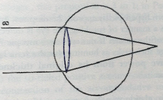
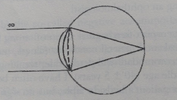
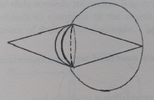
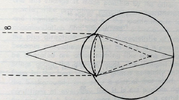
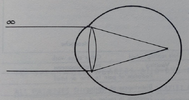
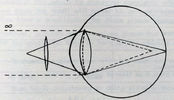
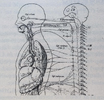
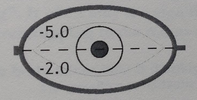
 . This quite descriptive clip shows the accommodation muscle getting cramped, and leading to myopia (though it doesn't go into pseudomyopia more closely, etc.):
. This quite descriptive clip shows the accommodation muscle getting cramped, and leading to myopia (though it doesn't go into pseudomyopia more closely, etc.):